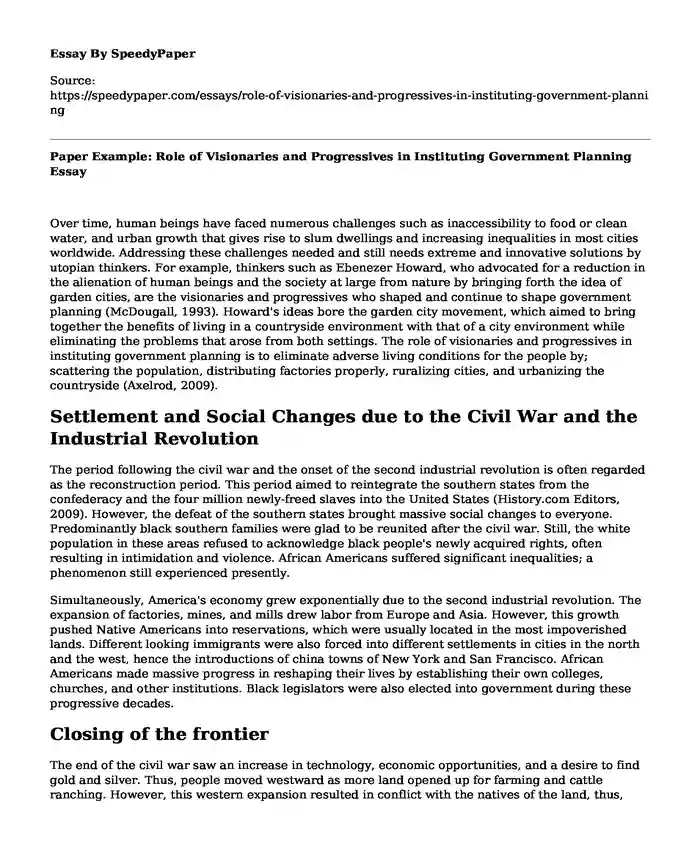
| Type of paper: | Essay |
| Categories: | Ecology Government Social responsibility Social issue |
| Pages: | 4 |
| Wordcount: | 928 words |
Over time, human beings have faced numerous challenges such as inaccessibility to food or clean water, and urban growth that gives rise to slum dwellings and increasing inequalities in most cities worldwide. Addressing these challenges needed and still needs extreme and innovative solutions by utopian thinkers. For example, thinkers such as Ebenezer Howard, who advocated for a reduction in the alienation of human beings and the society at large from nature by bringing forth the idea of garden cities, are the visionaries and progressives who shaped and continue to shape government planning (McDougall, 1993). Howard's ideas bore the garden city movement, which aimed to bring together the benefits of living in a countryside environment with that of a city environment while eliminating the problems that arose from both settings. The role of visionaries and progressives in instituting government planning is to eliminate adverse living conditions for the people by; scattering the population, distributing factories properly, ruralizing cities, and urbanizing the countryside (Axelrod, 2009).
Settlement and Social Changes due to the Civil War and the Industrial Revolution
The period following the civil war and the onset of the second industrial revolution is often regarded as the reconstruction period. This period aimed to reintegrate the southern states from the confederacy and the four million newly-freed slaves into the United States (History.com Editors, 2009). However, the defeat of the southern states brought massive social changes to everyone. Predominantly black southern families were glad to be reunited after the civil war. Still, the white population in these areas refused to acknowledge black people's newly acquired rights, often resulting in intimidation and violence. African Americans suffered significant inequalities; a phenomenon still experienced presently.
Simultaneously, America's economy grew exponentially due to the second industrial revolution. The expansion of factories, mines, and mills drew labor from Europe and Asia. However, this growth pushed Native Americans into reservations, which were usually located in the most impoverished lands. Different looking immigrants were also forced into different settlements in cities in the north and the west, hence the introductions of china towns of New York and San Francisco. African Americans made massive progress in reshaping their lives by establishing their own colleges, churches, and other institutions. Black legislators were also elected into government during these progressive decades.
Closing of the frontier
The end of the civil war saw an increase in technology, economic opportunities, and a desire to find gold and silver. Thus, people moved westward as more land opened up for farming and cattle ranching. However, this western expansion resulted in conflict with the natives of the land, thus, their alienation into reservations.
National Consciousness
The civil war changed much of America's national identity. In terms of democracy, even though shirt-lived, two million African American men became eligible to vote. Constitutional amendments of this period secured equal rights in the subsequent 20th century, and imperialism was birthed. Thus, the civil war brought on some changes in the ideals of democracy and citizenship, as well as in America's role in global affairs.
Children of the Poor
The second industrial revolution saw the rise of factories, which in turn needed workers. This demand for labor saw the uptake of children, who were seen as the ideal employees. This is because they could be paid less and were less likely to organize strikes due to the factories' deplorable working conditions then. Their small stature also meant that more minute tasks could be attended to at ease.
Company Towns
During the Second Industrial Revolution, companies in the textile, steel, coal, and other industries built communities for their workers and their families. These places had stores where workers could shop using exclusive currencies, schools that enrolled the worker's children, and houses where the workers lived (Hirsch, 2015).
Nature of the Natural Environment
The Second Industrial Revolution changed how everything was created. However, as technologies and the way of life improved, our natural environment suffered. The burning of fossil fuels, such as coal-generated emissions and smoke, caused air pollution. Factories built close to natural water resources polluted local water supplies through waste and landfills. Soils were also contaminated due to heavy metals and toxic chemicals that leached into the ground. Ecosystems, such as forests, were also destroyed to make the land for economic and settlement expansion, and also for the exploitation of resources such as timber and minerals (Folk, 2018).
Effect of Environmental Issues on the Legal Processes of Urban PlanningThe development of urban centers requires the integration of environmental concerns in the strategic plans. Metropolitan areas that are able to address ecological issues function sustainably. Those that fail to do so experience health hazards, biodiversity loss, and a lower quality of life (UNEP). The United States, for example, has several environmental laws that govern urban planning and address pollution such as the Clean Air Act, the Clean Water Act, and the Comprehensive Environmental Response, Compensation, and Liability Act.
References
Axelrod, J., B., C. (2009). Inventing autopia: Dreams and visions of the modern metropolis in jazz age Los Angeles. Berkeley: University of California Press.
Folk, E. (2018). Environmental Impacts of Industrialization. EcoMENA. Retrieved July 12, 2020, from https://www.ecomena.org/environmental-impacts-of-industrialization/Hirsch, M., L. (2015). America’s Company Towns, Then and Now. Smithsonian Magazine.
Travel. Retrieved July 12, 2020, from https://www.smithsonianmag.com/travel/americas-company-towns-then-and-now-180956382/History.com Editors. (2009). Reconstruction. Retrieved July 12, 2020, from https://www.history.com/topics/american-civil-war/reconstruction
McDougall, M. (1993). Journal of Architectural and Planning Research, 10(3), 266-268. Retrieved July 12, 2020, from www.jstor.org/stable/43028752
United Nations Environmental Programme. Urban Environment Planning. Retrieved July 12, 2020, from https://www.unenvironment.org/explore-topics/resource-efficiency/what-we-do/cities/urban-environmental-planning
Cite this page
Paper Example: Role of Visionaries and Progressives in Instituting Government Planning. (2023, Oct 03). Retrieved from https://speedypaper.com/essays/role-of-visionaries-and-progressives-in-instituting-government-planning
Request Removal
If you are the original author of this essay and no longer wish to have it published on the SpeedyPaper website, please click below to request its removal:
Popular categories




